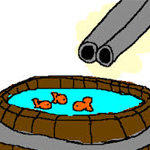 When Ben and I met, we were wrapt. Closer in age (and maturity) than most of the people at the seminar we were attending – it made it much more fun. Over the coming months we did a few bits and pieces together – the odd client project. It was a good time.
When Ben and I met, we were wrapt. Closer in age (and maturity) than most of the people at the seminar we were attending – it made it much more fun. Over the coming months we did a few bits and pieces together – the odd client project. It was a good time.
However, Ben was at capacity – he thought he was over capacity, I wasn’t far off. Neither of us had the income or the lifestyle we really wanted and the only option we had, was to work more. Worst of all, there was no equity being built. Just income, which inevitably gets spent.
Then there was another thing nagging at me, a testimonial from Gary Halbert about Dan Kennedy.
“Kennedy is one of the few copywriters out there, who is willing to put his money where his mouth is and writes his own copy to sell his own products.”
Makes sense – if I am such a good marketer and copywriter, why don’t I put my money where my mouth is and start my own business using my copy to sell my own products. A lot of copywriters and marketing consultants out there are frankly woeful; don’t know what they are doing and that is why they are in the advice business – those who ‘can’ ‘do’. (Consultant usually means unemployed professional after all)
Ben felt the same way about his marketing skills – he’d seen his clients take his ideas and make a mint with them.
From Little Things Big Things Grow
Long before I met Ben I had pondered starting ‘a done for them’ newsletter business. I knew I couldn’t do it alone. So I was looking for the right business partner for that monumental project.
Ben and I had a few nights together having a quiet drink and kicking around money making ideas including what would become Newsletter Marketing Systems.
After realising just how much demand there was for newsletters out there, Ben was certain that doing newsletters for other clients was just the way to go. We’d just seen 90% of the attendees at a seminar raise their hand and say they wanted to do a monthly printed customer newsletter. And one of them asked “who can do that for us?”
And the speaker said “I don’t know! Do it yourself.”
What started as a good idea in late 2011 has by the end of 2013 grown consistently and steadily. It’s taken longer than we wanted. But it has started to grow very rapidly in the last 6 months. And looks poised to double in size from its current levels by Easter.
 Pretty much everybody in business has business cards. There are some really good ones around, but most of them are pretty average, in fact most are actually very boring. (some are downright embarrassing)
Pretty much everybody in business has business cards. There are some really good ones around, but most of them are pretty average, in fact most are actually very boring. (some are downright embarrassing)






